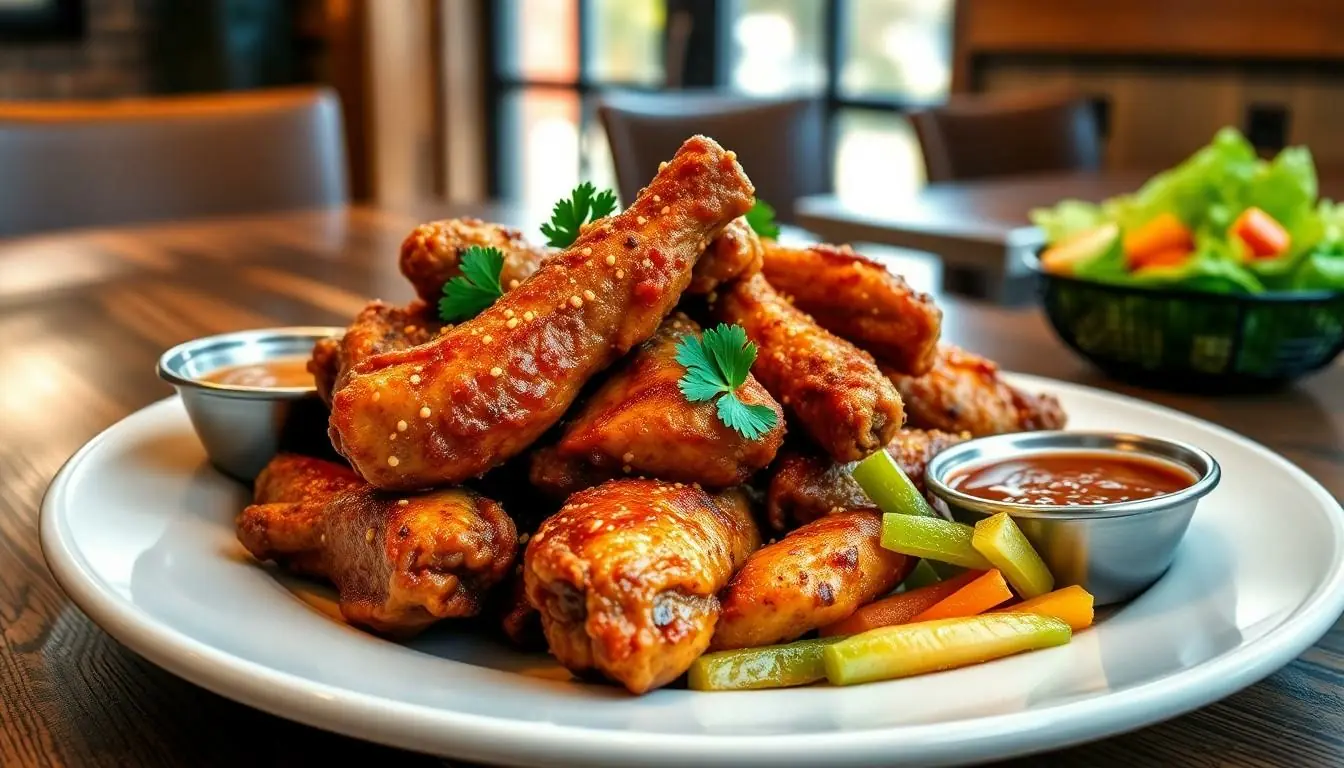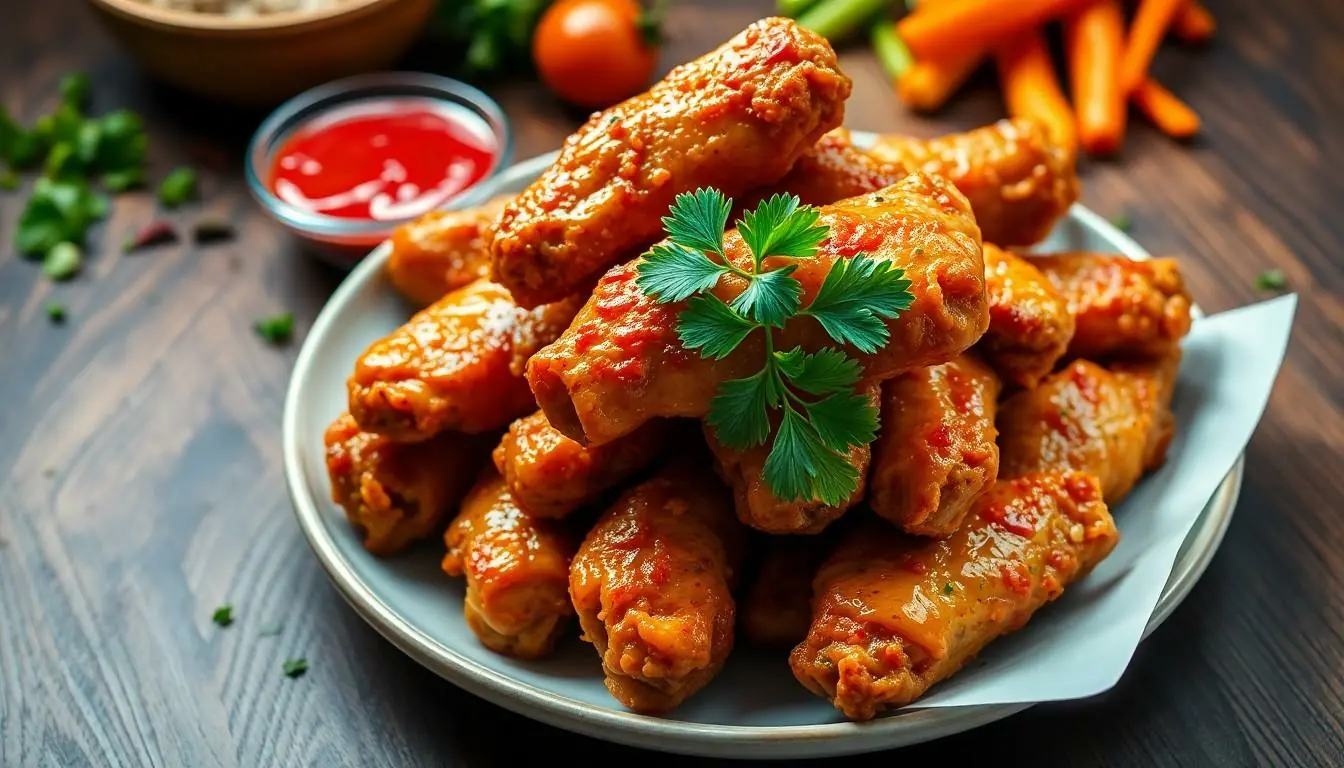When it comes to wings, few can resist the crispy, saucy goodness that makes every bite a flavor explosion. Whether they’re slathered in buffalo sauce or coated in a sweet teriyaki glaze, wings are a go-to snack for game days, parties, or just a casual Tuesday night. But before diving in, it’s worth taking a moment to consider what’s really hiding beneath that delicious exterior.
Wings pack a punch in taste, but how do they stack up nutritionally? Are they a guilt-free indulgence or a calorie bomb waiting to explode? Understanding the nutrition facts can help make informed choices, whether you’re a health-conscious eater or simply trying to balance indulgence with healthy habits. Let’s dive into the numbers behind these tasty morsels and discover what makes wings both a guilty pleasure and a surprisingly versatile dish.
Table of Contents
ToggleOverview of Wings Nutrition Facts
Chicken wings provide a range of nutritional values, making them a popular choice among appetizers. One medium-sized fried wing contains approximately 99 calories, which can vary based on cooking methods and sauces. Protein content is significant, with each wing offering around 6 grams, contributing to muscle repair and growth.
Fat content is another crucial aspect. Each medium wing contains roughly 7 grams of fat, including both saturated and unsaturated fats. For individuals monitoring their fat intake, skinless options or grilling methods can reduce overall fat content.
Carbohydrates in chicken wings are minimal, with approximately 0 grams per wing, making them a suitable option for low-carb diets. However, sauces or breading can increase this figure, especially in flavored wings like buffalo or barbecue.
Micronutrients also play a role in the nutritional profile. Chicken wings provide essential vitamins and minerals, including B vitamins such as niacin and vitamin B6, which support metabolism. Zinc and phosphorus present in wings contribute to immune function and bone health.
When assessing wings as a snack, the serving size matters. A typical serving often contains about 5 to 10 wings. Consuming larger portions may lead to higher calorie and fat intake, so moderation is key in enjoying this delicacy.
Dining occasions also influence choice. Wings pair well with vegetables or healthier sides, offering a balanced approach. Understanding the nutritional facts empowers informed decisions about indulging in this classic dish, ensuring enjoyment without compromising dietary goals.
Nutritional Components of Wings

Chicken wings provide a variety of nutrients. Understanding their composition helps in making informed dietary choices.
Protein Content
Chicken wings are a notable source of protein, with an average medium-sized fried wing containing approximately 6 grams. Protein plays a crucial role in muscle building and repair. Wings contribute to daily protein intake, especially when consumed in moderation. For those looking to increase protein consumption, opting for grilled or baked wings can further enhance nutritional benefits. Combining wings with protein-rich sides can create a well-rounded meal.
Fat Content
Wings generally contain about 7 grams of fat per medium-sized fried wing. The type of fat in wings varies, with a combination of saturated and unsaturated fats present. Choosing baked or grilled wings can lower overall fat content compared to fried options. Monitoring fat intake is essential, as higher portions can lead to increased calorie consumption. Cooking techniques greatly influence the fat levels in chicken wings, making preparation method a critical factor in their nutritional profile.
Carbohydrates
Carbohydrate content in chicken wings is minimal, making them a low-carb snack option. A typical medium-sized wing has virtually no carbohydrates. Those following low-carb diets may find wings appealing for this reason. However, sauces and coatings introduced during preparation can add significant carbs. Being mindful about added ingredients supports dietary goals while enjoying wings.
Health Benefits of Wings
Chicken wings provide notable health benefits that make them a satisfying snack choice. These benefits arise from their nutritional profile, which includes essential vitamins and minerals.
Source of Essential Nutrients
Wings serve as a source of essential nutrients that support overall health. Each medium-sized fried wing contains B vitamins, zinc, and phosphorus, which contribute to metabolic processes and immune function. Zinc plays a vital role in immune response and wound healing. Additionally, B vitamins, such as B6 and B12, assist in energy production and red blood cell formation. Phosphorus is crucial for maintaining healthy bones and teeth. By incorporating wings into a balanced diet, individuals can enjoy these vital nutrients while savoring their favorite dish.
Impact on Muscle Growth
Protein content in wings significantly impacts muscle growth and repair. Each medium-sized fried wing provides about 6 grams of protein, essential for building and maintaining muscle mass. Consuming protein after exercise aids in recovery and promotes muscle synthesis. Incorporating grilled or baked wings into meals increases protein intake without excessive calories, enhancing overall nutrition. Mindful selection of cooking methods also helps manage fat content, creating a healthier option for fitness enthusiasts. With proper preparation, wings become an effective protein source to support an active lifestyle.
Considerations When Eating Wings
Enjoying chicken wings requires thoughtful consideration of both portion sizes and cooking methods. These factors significantly influence the overall nutritional value of the dish.
Portion Control
Portion control plays a crucial role in managing calorie intake. A typical medium-sized fried wing contains around 99 calories. Consuming multiple wings can quickly lead to a high-calorie meal. People often underestimate the cumulative effects of serving sizes, so being mindful is essential. For instance, opting for a smaller plate or sharing with friends can help curb overindulgence. Additionally, pairing wings with healthier sides, like vegetables or salads, can balance the meal without excessive calories.
Cooking Methods and Their Impact
Cooking methods largely determine the nutritional profile of chicken wings. Fried wings typically contain about 7 grams of fat each, while grilled or baked options can significantly lower fat content. Grilling or baking helps retain protein levels while reducing added calories. Utilizing healthier sauces or spices instead of heavy coatings also enhances flavor without packing on extra calories. Choosing these methods can support healthier eating habits while satisfying cravings for chicken wings.
Chicken wings can be a delicious addition to any meal when enjoyed mindfully. Their nutritional profile offers essential proteins and vitamins that support overall health. By choosing healthier cooking methods and being aware of portion sizes, it’s possible to savor these tasty treats without derailing dietary goals.
Pairing wings with nutritious sides can create a balanced plate, allowing for a satisfying experience. Ultimately, understanding the nutritional facts empowers individuals to make informed choices and enjoy chicken wings as part of a healthy lifestyle.




